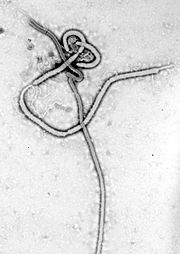PLEASE
Add comments.
Click ads.
Visit regularly.
Subscribe RSS
Toolbar
Listen
Indian users get free
medical updates
to ur mobile life time.
to ur mobile life time.
Just sms:
JOIN GUIDE4MEDICOS
JOIN GUIDE4MEDICOS
to 9870807070.
Sep 17, 2009
Ebola Hemorrhagic Fever
Ebola is the term for the viral genus Ebolavirus (EBOV), or for the disease Ebola hemorrhagic fever (EHF). It is named after the Ebola River, where the first recognized outbreak occurred. There are a number of species within the ebolavirus genus, which in turn have a number of specific strains or serotypes. The Zaire virus is the type species, which is also the first discovered and the most lethal.
Electron micrographs show long filaments, characteristic of the Filoviridae viral family. The virus interferes with the endothelial cells lining the interior surface of blood vessels and platelet cells. As the blood vessel walls become damaged and the platelets are unable to coagulate, patients succumb to hypovolemic shock. Ebola is transmitted primarily through bodily fluids and to a limited extent through skin and mucous membrane contact.
Transmission
- The Ebola virus is transmitted by direct contact with the blood, secretions, organs or other body fluids of infected persons.
- Burial ceremonies where mourners have direct contact with the body of the deceased person can play a significant role in the transmission of Ebola.
- The infection of human cases with Ebola virus through the handling of infected chimpanzees, gorillas, and forest antelopes -- both dead and alive -- has been documented in Côte d'Ivoire, the Republic of Congo and Gabon. The transmission of the Ebola Reston strain through the handling of cynomolgus monkeys has also been reported.
- Health care workers have frequently been infected while treating Ebola patients, through close contact without correct infection control precautions and adequate barrier nursing procedures.
Symptoms
Ebola is characterized by the sudden onset of fever, intense weakness, muscle pain, headache and sore throat. This is often followed by vomiting, diarrhoea, rash, impaired kidney and liver function, and in some cases, both internal and external bleeding. Laboratory findings show low counts of white blood cells and platelets as well as elevated liver enzymes.
Labels:
Informations
Subscribe to:
Post Comments (Atom)
Check here
- Downloads (5)
- Follow us (2)
- Informations (12)
- Interactives (1)
- MCQ (4)
- Medical books (2)
- News (1)
- Rare pictures (4)
- Videos (3)
Blog Archive
-
▼
2009
(25)
-
▼
September
(15)
- Artificial heart valves
- World heart day: Sept 27
- Watch these videos
- Explore your ear lobes
- CPR
- AIPPG: MCQS
- Medical dictionary
- Ebola Hemorrhagic Fever
- Amazing Isn't it ??
- Mysthenia Gravis
- Some useful books
- Open heat surgery
- The Amazing Journey of Conception From Egg to Embryo
- Swine FLU
- Follow us on twitter
-
▼
September
(15)

0 comments:
Post a Comment